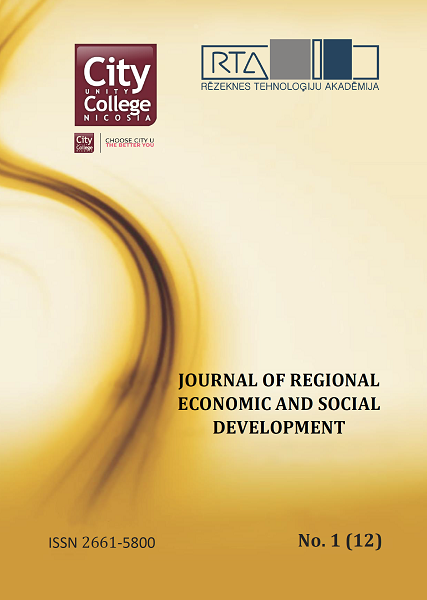TRENDS AND THE IMPLICATIONS OF CHANGE IN PUBLIC DEBT IN LATVIA
DOI:
https://doi.org/10.17770/jresd2020vol1.12.5391Keywords:
public debt, implications, national economy, economic growthAbstract
An analysis of various research papers reveals that an increase in public debt has helped nations to restart economic growth; therefore, the research on public debt is still urgent and relevant.
The aim of the present research is to examine trends and the implications of change in the public debt of Latvia.
The research results revealed that over a ten-year period (2009-2018), the government budget of Latvia had a surplus only in one year (2016), which was due to the fact that the growth rate of budgetary revenues exceeded that of the national economy.
The research results also revealed that public debt explicitly had more negative than positive implications. The positive implications involve increases in income for the population (interest payments on debt securities) and revenue for the government budget (to cover expenditures). The negative implications of public debt for the national economy mostly involve a potential downgrade of the country’s credit rating, which could lead to difficulties in raising funds during a crisis.
The research employed the following methods: monographic, induction and deduction, graphical, comparison, a sociological research method – expert surveying – and statistical analysis.
Downloads
References
Bank of Latvia. (23 September 2014). Debt Securities (short-term and long-term). Retrieved from https://www.bank.lv/auditorijas/medijiem/264-statistika/statistika-izmantotie-termini/8108-stermia-parda-vrtspapri-
Birka, A. (2013). Government External Debt and its Management. Retrieved from https://www.bank.lv/statistika/informacija-statistikas-lietotajiem/pazinojumi/403-publikacijas/averss-un-reverss/4750-valsts-arejais-parads-un-ta-parvaldisana
Bua, G., Pradelli, J., Presbitero, A. (2014). Domestic public debt in Low-Income Countries: Trends and structure. Review of Development Finance, .4, 1-12. Retrieved from https://reader.elsevier.com/reader/sd/pii/S1879933714000037?token=E3332D9A4A29BACF3A0B3169477C94190673649C5F709BE4F38AE946C32CB18B4CB12F0BC4D158CD62CB5E468C20B7E1
Central Statistical Bureau database. (18 October 2019). General government debt by sub-sector and quarter at end of period (mln euro). Retrieved from https://data1.csb.gov.lv/pxweb/lv/ekfin/ekfin__valdfin__ikgad/VFG050.px/table/tableViewLayout1/
Central Statistical Bureau. (21 April 2015). The general government budget deficit in 2014 was 1.4% of GDP. Retrieved from https://www.csb.gov.lv/lv/statistika/statistikas-temas/ekonomika/valdibas-finanses/meklet-tema/1725-par-valsts-budzeta-deficita-un-parada
Dumitrescu, B. (2014). The public debt in Romania – factors of influence, scenarios for the future and a sustainability analysis considering both a finite and infinite time horizon. Procedia Economics and Finance, 8, 284. (283-292). Retrieved from https://reader.elsevier.com/reader/sd/pii/S2212567114000926?token=44A589E4F1700AE08C66622368370129427E3CD5A72B022FAD42D2C2EFB657DD97631C9AC6E8F81DD5F8F61002220C28
Fiscal Discipline Council. (2016., marts.). Latvian Government Debt. Deficit and Aging. Retrieved from https://fdp.gov.lv/files/uploaded/20161201_VParads_LV.pdf
Fridrihsone, M. (5 January 2017). Latvia's Public Debt has Risen again and is Approaching a Historically High Level. Latvian Public Media. Retrieved from https://www.lsm.lv/raksts/zinas/ekonomika/latvijas-valsts-parads-atkal-pieaudzis-un-pietuvojies-vesturiski-augstakajam-limenim.a217635/
Furman, J., Summers, L. (2019). Who`s Afraid of Budget Deficits? How Washington Should End Its Debt Obsession. Foreign Affairs, 98(2), 82.-95. Retrieved from http://web.a.ebscohost.com/ehost/pdfviewer/pdfviewer?vid=5&sid=faab06d7-56dc-4a6d-92fb-015528bf7e7b%40sessionmgr4007
Galinski, P. (2015). Determinants of debt limits in local governments: case of Poland. Procedia – Social and Behavioral Sciences, 213, 376-382. Retrieved from https://reader.elsevier.com/reader/sd/pii/S1877042815059091?token=FD72438BCE05B74DB7B9CF5683485295929993910655171C2FA78E8A815801B20162AEE42643970D044BBEAEE29EF1A6
Kamiguchi, A., Tamai, T. (2019). Public investments, public debt, and population aging under the golden rules of public finance. Journal of Macroeconomics, 60, 110-122. Retrieved from https://reader.elsevier.com/reader/sd/pii/S0164070418303793?token=3B44E88667F5FA94D166C2D77F5AF9F1F20DDE490A177A2B862A0E4B5A04DC3D52B07DA98588FB42D9334A79D19C5784
Kasalis, E., Skribāne, I. (2007). Theoretical Aspects of an Analysis of a Current Account Deficit of the Balance of Payments. E. Dubra (ed.). Proceedings of the University of Latvia, Economics. (vol. 718). Riga: University of Latvia, 168-177.
Law on Fiscal Discipline of the Republic of Latvia. (31 January 2013). Retrieved from https://likumi.lv/ta/id/254896-fiskalas-disciplinas-likums
LETA. (9 March 2019). In 2018, the Government Debt Reached 10.2 Billion Euros. Retrieved from https://www.diena.lv/raksts/latvija/zinas/2018.-gada-valsts-parads-sasniedzis-102-miljardus-eiro-14215875
Levi., M.D. (2014). The Macroeconomic Environment of Business. Core Concepts and Curious Connections. Singapore: World Scientific Publishing Co.
Libermanis, G. (2001). Tirgus ekonomikas pamati un Latvija ceļā uz Eiropas Savienību. Rīga: Kamene.
Ludvigson, S. (1996). The macroeconomics effects of government dept in a stochastic growth model. Journal of Monetary Economics, 38 (1), 25-45.
Piketī, T. (2015). Kapitāls 21. gadsimtā. Rīga: Lauku bibliotēku atbalsta biedrība.
Regulations regarding the Classification of General Government Debt. (8 November 2005). Cabinet Regulation No. 842. Retrieved from https://likumi.lv/doc.php?id=121091
Reinhart, C.M., Rogoff, K.S. (2010). Growth in a Time of Debt. American Economic Review: Papers & Proceeding. 573-578. Retrieved from https://scholar.harvard.edu/files/rogoff/files/growth_in_time_debt_aer.pdf
Rosen, H.S., Gayer, T. (2014). Public Finance. Glasgow: Bell and Bain Ltd.
Semjonova, N. (2017). Government debt: evaluation of financial security and optimal policy selection: Scientific Monograph – Riga: RTU Press.
Šenfelde, M. (2014). Macroeconomics. Riga: RTU Publishing House.
Tkačevs, O. (3 May 2011). Negative Effects of Government Debt. Retrieved from https://www.makroekonomika.lv/valdibas-parada-slikta-ietekme
Treasury. (3 October 2017). Interest-free Bonds. Retrieved from https://www.kase.gov.lv/valsts-parada-vadiba/bezprocentu-obligacijas
Treasury. [s.a.]. What are Savings Bonds? https://www.krajobligacijas.lv/static/aboutSavingNotes, Access: 29.03.2020.
Vilerts, K. (8 February 2018). Latvian Government Debt Development and Risks. Retrieved from https://www.makroekonomika.lv/latvijas-valdibas-parada-attistiba-un-riski


